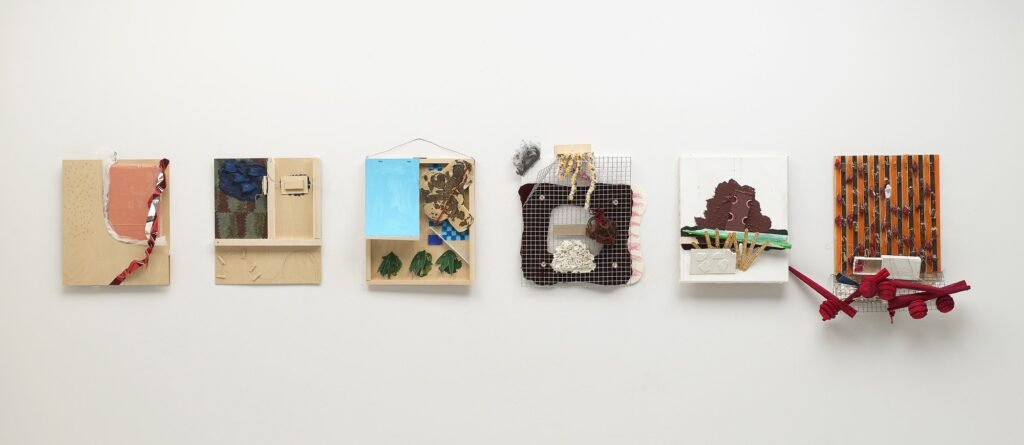Richard Tuttle BIOGRAPHY

Richard Tuttle’s Early Life and Education
Born in Rahway, New Jersey in 1941, Richard Tuttle’s artistic journey began with introspection and a keen observation of his environment. This early inclination towards contemplation significantly influenced his artistic development.
His time at Trinity College, Connecticut, shaped his artistic path. There, amidst academic challenges, Tuttle’s interest in art evolved into a dedicated pursuit.
Moreover, Tuttle’s transition from a reflective observer in New Jersey to an engaged art student in Connecticut highlights the formative stages of his entry into the art world.
Development as an Artist
Post-education, Tuttle’s artistic trajectory took a definitive turn. Immersed in the vibrant New York art scene of the 1960s, he absorbed the influences around him, yet his style remained distinctively his own.
Tuttle experimented with scale and material, embracing a minimalist ethos with a personal twist. His work, often characterized by subtle, almost ephemeral qualities, defied conventional categorization, earning him both admiration and critique in the art community.
Major Turning Points in Richard Tuttle’s Career
Tuttle’s career is marked by several pivotal moments. A major turning point in his career was his 1965 Betty Parsons Gallery solo exhibition, which brought him to the general public’s attention. Later, his participation in the 1975 Whitney Biennial sparked controversy yet solidified his reputation as a revolutionary artist.
A turning point came with his later large-scale textile works, which challenged preconceived notions about form and structure, further establishing him as a master of spatial and material innovation.
What is Richard Tuttle known for?

Richard Tuttle’s art stands out for its deliberate understatement and tactile simplicity. His signature style defies grandiosity, focusing instead on the subtle interplay of color, form, and material. Tuttle often employs everyday materials like plywood, styrofoam, and string, transforming them into thought-provoking pieces.
His techniques involve a meticulous yet seemingly casual assembly of elements, creating works that resonate with a quiet, reflective energy. This approach has made Tuttle a distinctive voice in contemporary art, revered for his ability to find profound meaning in minimalistic expressions.
Major Themes in Tuttle’s Work
Tuttle’s work consistently explores themes of perception and space. He challenges viewers to reconsider their understanding of art and its relationship to the surrounding environment.
His pieces often evoke a sense of fragility and temporality, prompting reflections on the ephemeral nature of existence. Tuttle’s art is not just visual; it’s an experiential journey that equally engages the viewer’s senses and intellect.
Who inspired Richard Tuttle?
Richard Tuttle, a prominent post-minimalist artist, drew inspiration from various sources that shaped his unique artistic style. The works of minimalist artists like Agnes Martin and Donald Judd influenced him.
However, Tuttle’s approach diverged significantly, focusing on a more personal and less industrial aesthetic. His work is characterized by a delicate, almost ephemeral quality, often using unconventional materials. Other key influences include
Poetry and Language: Tuttle was also deeply influenced by poetry, evident in his lyrical and oftenwhimsical nature.
- Everyday Materials: Tuttle frequently incorporated everyday items into his art, challenging traditional notions of what constitutes an art medium.
Tuttle’s unique blend of minimalism, poetry, and unconventional materials created a distinct style that set him apart in art.
Contributions to Postminimalism
Tuttle’s contributions to postminimalism are significant. He expanded the boundaries of this movement, introducing a sense of personal narrative and emotional depth often absent in minimalism.
His work defies minimalist art’s stark, impersonal nature, infusing it with a delicate, human touch. This has earned Tuttle a place among the pioneers who reshaped contemporary art, bridging the gap between minimalistic restraint and expressive richness.
His influence is evident in how subsequent generations of artists approach materials, form, and the essence of artistic expression.
Career highlights

Notable Exhibitions and Shows
Richard Tuttle’s career is marked by several significant exhibitions that cemented his status in art. His first breakthrough came with the solo exhibition at the Betty Parsons Gallery in 1965, a renowned space for avant-garde art. This was followed by his influential participation in the 1975 Whitney Biennial, a show that sparked much debate and furthered his reputation as Shuttle’s ring artist.
These two exhibitions, strategically spaced a decade apart, mark pivotal moments in Tuttle’s rise. The Parsons Show, a springboard for emerging talent, offered immediate validation within the influential avant-garde scene.
Ten years later, the Whitney Biennial, a prestigious and often contentious platform, solidified his artistic identity through the now-iconic “Shuttle’s Ring” series, solidifying his place in the contemporary art landscape.
Awards and Recognitions
Renowned for his unique explorations of form and material, Richard Tuttle has garnered prestigious accolades throughout his career. Awards from esteemed institutions like the Art Institute of Chicago and the Ludwig Forum für Internationale Kunst are a testament to his groundbreaking contributions to contemporary art.
These honors, exceeding mere recognition of his artistic prowess, speak volumes about his profound influence on the trajectory of post-minimalist art.
Collaborations and Partnerships
Tuttle’s collaborative projects reflect his versatility and willingness to explore new artistic territories. He has worked alongside architects, designers, and musicians, bringing a unique artistic perspective to interdisciplinary projects.
These collaborations have allowed Tuttle to extend his artistic language beyond traditional gallery spaces, engaging broader audiences and redefining the boundaries between art forms.
Richard Tuttle List of Work

Pioneering Works and Installations
Richard Tuttle’s early works set the tone for his distinctive style. Following are his notable pioneering works and installations.
“10th Copper Piece” (1970): Innovative copper and shadow sculpture.
“Purple Octagonal” (1967): Blends painting and sculpture.
Recent Projects and Exhibits
“Systems, VIII–XII” (2018), NY: Space, material mastery.
“The Stars” (2020), Brooklyn Museum: Nature-themed drawings.
Critically Acclaimed Pieces
“Wire Piece” (1972): Alters space perception.
“Red Canvas” (1967): Minimalist, color-focused canvas.
“Textile Works” Series: Reimagines traditional textiles
What materials does Richard Tuttle use?
Richard Tuttle is known for innovatively using diverse materials in his artwork. Here are some of the materials he frequently incorporates:
Wire
Wood
Paper
Fabric
Canvas
Copper
Watercolor and Graphite
String
Found Objects
Acrylic Paint
Tuttle’s unique approach to these materials is central to his artistic expression, blurring the lines between traditional art forms and creating new visual languages.
